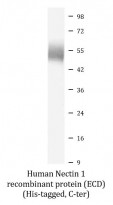ARG70334
Human Nectin 1 recombinant protein (ECD) (His-tagged, C-ter)
Human Nectin 1 recombinant protein (ECD) (His-tagged, C-ter) for Binding Activity,SDS-PAGE and Human
Overview
| Product Description | HEK293 expressed, His-tagged (C-ter) Human Nectin 1 recombinant protein (ECD). |
|---|---|
| Tested Reactivity | Hu |
| Tested Application | Binding, SDS-PAGE |
| Target Name | Nectin 1 (ECD) |
| Species | Human |
| A.A. Sequence | Met1 - Thr334 of Human Nectin 1 (NP_002846.3) with 6X His tag at the C-terminus. |
| Expression System | HEK293 |
| Alternate Names | HveC; nectin-1; PVRR1; PVRR; HV1S; Nectin-1; PRR1; HIgR; SK-12; CD111; CD antigen CD111; Herpesvirus Ig-like receptor; CLPED1; OFC7; ED4; PRR; Herpes virus entry mediator C; Herpesvirus entry mediator C; Poliovirus receptor-related protein 1; HVEC |
Application Instructions
| Application Note | Binding activity test: Measured by its binding ability in a functional ELISA. Immobilized Recombinant Human Nectin-1 3µg/ml (100 µl/well) can bind Recombinant Human Nectin-3 with a linear range of 180-720 ng/ml. |
|---|
Properties
| Form | Powder |
|---|---|
| Purification Note | 0.22 µm filter sterilized. Endotoxin level is <0.1 EU/µg of the protein, as determined by the LAL test. |
| Purity | >97% (by SDS-PAGE) |
| Buffer | PBS (pH 7.4) |
| Reconstitution | Reconstitute to a concentration of 0.1 - 0.5 mg/ml in sterile distilled water. |
| Storage Instruction | For long term, lyophilized protein should be stored at -20°C or -80°C. After reconstitution, aliquot and store at -20°C for up to one month, at 2-8°C for up to one week. Storage in frost free freezers is not recommended. Avoid repeated freeze/thaw cycles. Suggest spin the vial prior to opening. |
| Note | For laboratory research only, not for drug, diagnostic or other use. |
Bioinformation
| Gene Symbol | PVRL1 |
|---|---|
| Gene Full Name | poliovirus receptor-related 1 (herpesvirus entry mediator C) |
| Background | This gene encodes an adhesion protein that plays a role in the organization of adherens junctions and tight junctions in epithelial and endothelial cells. The protein is a calcium(2+)-independent cell-cell adhesion molecule that belongs to the immunoglobulin superfamily and has 3 extracellular immunoglobulin-like loops, a single transmembrane domain (in some isoforms), and a cytoplasmic region. This protein acts as a receptor for glycoprotein D (gD) of herpes simplex viruses 1 and 2 (HSV-1, HSV-2), and pseudorabies virus (PRV) and mediates viral entry into epithelial and neuronal cells. Mutations in this gene cause cleft lip and palate/ectodermal dysplasia 1 syndrome (CLPED1) as well as non-syndromic cleft lip with or without cleft palate (CL/P). Alternative splicing results in multiple transcript variants encoding proteins with distinct C-termini. [provided by RefSeq, Oct 2009] |
| Function | Promotes cell-cell contacts by forming homophilic or heterophilic trans-dimers. Heterophilic interactions have been detected between NECTIN1 and NECTIN3 and between NECTIN1 and NECTIN4. Has some neurite outgrowth-promoting activity. (Microbial infection) Acts as a receptor for herpes simplex virus 1/HHV-1, herpes simplex virus 2/HHV-2, and pseudorabies virus/PRV. [UniProt] |
| Cellular Localization | Isoform Alpha: Cell membrane; Single-pass type I membrane protein. Cell junction, synapse, presynaptic cell membrane. Isoform Delta: Cell membrane; Single-pass type I membrane protein. Isoform Gamma: Secreted. [UniProt] |
| Calculated MW | 57 kDa |
Images (1) Click the Picture to Zoom In






